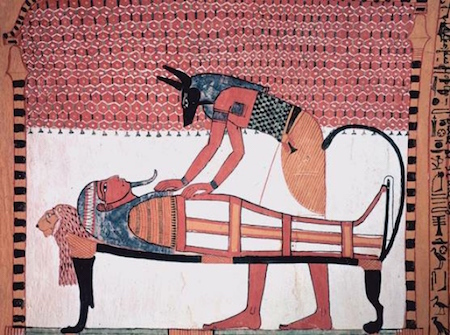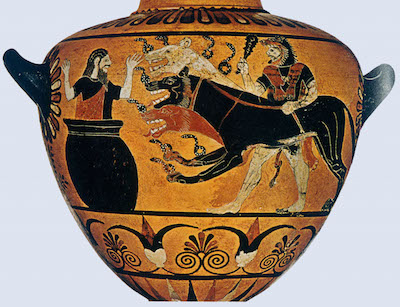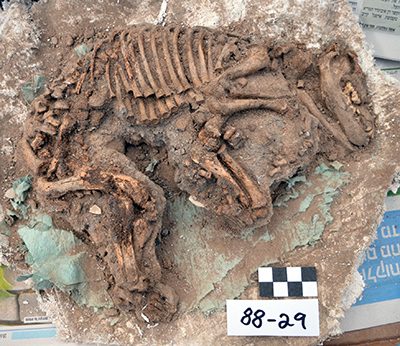Animal Magnetism (2)
By:
August 27, 2016
HiLobrow friend and contributor Colin Dickey is author of Cranioklepty & Afterlives of the Saints, as well as a forthcoming book on haunted houses, Ghostland. HILOBROW is pleased to present a brief series of Colin’s previously published essays regarding animals.

Outside Are the Dogs
You shall not bring the fee of a prostitute or the wages of a dog into the house of the Lord your God in payment for any vow, for both of these are an abomination to the Lord your God. — Deuteronomy 23:18
What, exactly, are the wages of a dog? What is its cost, its earnings — what is to be kept out of the temple, and what, exactly, is the abomination at work here? The phrase, sometimes translated as “the price of a dog,” appearing in an otherwise straightforward line in Deuteronomy, has long posed a problem to commentators, though one often quickly dismissed. The previous verse specifically focuses on banning “cult prostitutes,” those priests and priestesses of fertility cults that were anathema to early Judaism. Deuteronomy 23:17 only focuses on religious prostitution, though, and so a following verse, decrying all forms of sex work was necessary; in this context, it makes sense to interpret the wages of a dog as having to do with some manner of sex work, or some other sexual immorality. This verse has nothing to do with dogs at all, we conclude, the word just a figure of speech for something else.

Given the context, many scholars over the years have read the phrase as indicating a male prostitute. “Dog” is translated as ‘sodomite’ in the Revised Standard Edition of the Bible,” Bonnie J. Morris comments, “and this rendering is upheld by Louis Epstein, Norm Lamm, and other scholars of Jewish sexual ethics, based on Sanhedrin 24b.” Rendering “dog” as a male prostitute offers a simple solution to the problem, handily defusing any potential misunderstanding or opacity.
But if so, it is a strange moment in Deuteronomy; the rest of the chapter is strictly literal, and so the sudden interruption of a figure of speech seems aberrant in its own way, particularly coming as it does in such a literal discussion of prostitution. Reading “the wages of a dog” as a figure of speech makes logical sense, perhaps, but it blurs semantic coherency, as though we’re given a choice between two competing kinds of meaning. Several translations have done away with the word altogether, rendering “dog” simply as a “sodomite” or “male prostitute” (New International Version, International Standard Version), as though to simply make the problem go away.

Commentators will sometimes point to Revelation 22:15 as support for this move: “Outside the city are the dogs — the sorcerers, the sexually immoral, the murderers, the idol worshipers, and all who love to live a lie.” But even here things are not as simple as they seem. The foregoing is the New Living Translation, whereas the New International Version has “Outside are the dogs, those who practice magic arts, the sexually immoral, the murderers, the idolaters and everyone who loves and practices falsehood,” and the King James has “For without are dogs, and sorcerers, and whoremongers, and murderers, and idolaters, and whosoever loveth and maketh a lie.” The New Living Translation, and others like it, are emphatic that “dogs” are a figure of speech for various classes of the unclean; the King James, however, explicitly offers an opposite reading, seeing them as merely associates of the unclean. The New International Version, as with many other translations, is studiously ambiguous in its phrasing.
We know that the dogs are with the immoral and the unclean, but we don’t know exactly what this means, for them or for us. The dog runs through the Bible, a figure of disgust and a figure of speech, but never fully present, never fully understood. It is unclean, but even more than that, it is unknown.
Recent archeological discoveries have in turn complicated things further. For we are coming to understand that one of the hallmarks of human civilization, stretching back thousands of years and appearing throughout the world, is dog burial. While in some cases it may be that these dogs were buried for sanitation reasons, ritual burial appears widespread, and we know that dogs were regularly used for various healing purposes.
Dogs were already venerated for magic powers by the late Bronze Age, and reverentially used in funeral rites to protect the deceased as they traveled to the Underworld; Zoroastrians in India believed that looking upon a dog at death facilitates an easier journey of the soul to the afterlife. One ancient ritual, known as periskylakismos, involved the ritual cleansing by rubbing a puppy against the bodies of the devotees in association with Hecate (the dogs were later sacrificed). As a multipurpose symbol, the dog offers a variety of valences to different cults and religious sects. Their associations with guarding and protection, along with fidelity, have long made them symbolically important to the dead, as guides who protect and watch over soul. Additionally, dogs have also been associated with healing, in part due to the belief that a dog’s saliva had natural healing properties.

A few decades ago a massive pet cemetery was discovered in Ashkelon, a coastal city to the south of Tel Aviv. The archeological site was filled with hundreds of dogs — over 700 by some estimates, mostly puppies, and with no visible signs of trauma or disease. The puppies at Ashkelon, runs one hypothesis, were bred for use in rituals, and the discarded puppies were those who, for whatever reason, were unfit for sacrifice or healing.
And so, it may very well be the case that the “wages of a dog” is far from a figure of speech; they may have been the fees associated with those priests who worked these pagan rites, who collected revenue in association with breeding dogs and using them in ritual. In the context of a discussion of unacceptable religious practices such as cult prostitution, those who make the wages of a dog, perhaps, are simply those priests whose cults involve dog sacrifice.
Perhaps this thesis is also dubious; it is certainly far from definitive. And so the inability to derive a clear meaning of this passage speaks, perhaps, to a larger question of confusion and mystery, both in our relationship to those ancient texts on which we rely so much, and in our much older relationship to the dog.
CURATED SERIES at HILOBROW: UNBORED CANON by Josh Glenn | CARPE PHALLUM by Patrick Cates | MS. K by Heather Kasunick | HERE BE MONSTERS by Mister Reusch | DOWNTOWNE by Bradley Peterson | #FX by Michael Lewy | PINNED PANELS by Zack Smith | TANK UP by Tony Leone | OUTBOUND TO MONTEVIDEO by Mimi Lipson | TAKING LIBERTIES by Douglas Wolk | STERANKOISMS by Douglas Wolk | MARVEL vs. MUSEUM by Douglas Wolk | NEVER BEGIN TO SING by Damon Krukowski | WTC WTF by Douglas Wolk | COOLING OFF THE COMMOTION by Chenjerai Kumanyika | THAT’S GREAT MARVEL by Douglas Wolk | LAWS OF THE UNIVERSE by Chris Spurgeon | IMAGINARY FRIENDS by Alexandra Molotkow | UNFLOWN by Jacob Covey | ADEQUATED by Franklin Bruno | QUALITY JOE by Joe Alterio | CHICKEN LIT by Lisa Jane Persky | PINAKOTHEK by Luc Sante | ALL MY STARS by Joanne McNeil | BIGFOOT ISLAND by Michael Lewy | NOT OF THIS EARTH by Michael Lewy | ANIMAL MAGNETISM by Colin Dickey | KEEPERS by Steph Burt | AMERICA OBSCURA by Andrew Hultkrans | HEATHCLIFF, FOR WHY? by Brandi Brown | DAILY DRUMPF by Rick Pinchera | BEDROOM AIRPORT by “Parson Edwards” | INTO THE VOID by Charlie Jane Anders | WE REABSORB & ENLIVEN by Matthew Battles | BRAINIAC by Joshua Glenn | COMICALLY VINTAGE by Comically Vintage | BLDGBLOG by Geoff Manaugh | WINDS OF MAGIC by James Parker | MUSEUM OF FEMORIBILIA by Lynn Peril | ROBOTS + MONSTERS by Joe Alterio | MONSTOBER by Rick Pinchera | POP WITH A SHOTGUN by Devin McKinney | FEEDBACK by Joshua Glenn | 4CP FTW by John Hilgart | ANNOTATED GIF by Kerry Callen | FANCHILD by Adam McGovern | BOOKFUTURISM by James Bridle | NOMADBROW by Erik Davis | SCREEN TIME by Jacob Mikanowski | FALSE MACHINE by Patrick Stuart | 12 DAYS OF SIGNIFICANCE | 12 MORE DAYS OF SIGNIFICANCE | 12 DAYS OF SIGNIFICANCE (AGAIN) | ANOTHER 12 DAYS OF SIGNIFICANCE | UNBORED MANIFESTO by Joshua Glenn and Elizabeth Foy Larsen | H IS FOR HOBO by Joshua Glenn | 4CP FRIDAY by guest curators
